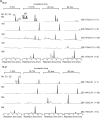Human and rat microsomal metabolites of N-tert-butoxycarbonylmethamphetamine and its urinary metabolites in rat
- PMID: 36454489
- PMCID: PMC9715518
- DOI: 10.1007/s11419-021-00595-6
Human and rat microsomal metabolites of N-tert-butoxycarbonylmethamphetamine and its urinary metabolites in rat
Abstract
Purpose: N-tert-Butoxycarbonylmethamphetamine (BocMA), a masked derivative of methamphetamine (MA), converts into MA under acidic condition and potentially acts as a precursor to MA following ingestion. To investigate the metabolism and excretion of BocMA, metabolism tests were conducted using human liver microsomes (HLM), rat liver microsomes (RLM) and rat.
Methods: BocMA metabolites were analyzed after 1000-ng/mL BocMA incubation with microsomes for 3, 8, 13, 20, 30, and 60 min. Rats were administered intraperitoneal injections (20 mg/kg) of BocMA and their urine was collected in intervals for 72 h. Metabolites were detected by liquid chromatography-tandem mass spectrometry with five authentic standards.
Results: Several metabolites including 4-hydroxy-BocMA, N-tert-butoxycarbonylephedrine and N-tert-butoxycarbonyl-cathinone were detected for HLM and RLM. In the administration test, three glucuronides of hydroxylated metabolites were detected. The total recovery values of BocMA and the metabolites during the first 72 h accounted for only 0.3% of the administered dose. Throughout the microsomal and administration experiments, MAs were not detected.
Conclusion: Hydroxylation, carbonylation and N-demethylation were proposed as metabolic pathways. However, BocMA and phase I metabolites were hardly detected in urine. This study provides useful information to interpret the possibility of BocMA intake as the cause of MA detection in biological sample.
Keywords: LC–MS/MS; Metabolite; Methamphetamine; Microsomes; N-tert-Butoxycarbonylmethamphetamine; Rat.
© 2021. The Author(s).
Conflict of interest statement
The authors have no conflict of interest to declare.
Figures







Similar articles
-
Elucidation of the metabolites of the novel psychoactive substance 4-methyl-N-ethyl-cathinone (4-MEC) in human urine and pooled liver microsomes by GC-MS and LC-HR-MS/MS techniques and of its detectability by GC-MS or LC-MS(n) standard screening approaches.Drug Test Anal. 2015 May;7(5):368-75. doi: 10.1002/dta.1682. Epub 2014 Jun 22. Drug Test Anal. 2015. PMID: 24953431
-
2-methiopropamine, a thiophene analogue of methamphetamine: studies on its metabolism and detectability in the rat and human using GC-MS and LC-(HR)-MS techniques.Anal Bioanal Chem. 2013 Apr;405(10):3125-35. doi: 10.1007/s00216-013-6741-4. Epub 2013 Jan 30. Anal Bioanal Chem. 2013. PMID: 23361230
-
Determination of species-difference in microsomal metabolism of amitriptyline using a predictive MRM-IDA-EPI method.Chem Biol Interact. 2015 Mar 5;229:109-18. doi: 10.1016/j.cbi.2015.01.024. Epub 2015 Jan 23. Chem Biol Interact. 2015. PMID: 25623954
-
Chiral analyses of dextromethorphan/levomethorphan and their metabolites in rat and human samples using LC-MS/MS.Anal Bioanal Chem. 2011 Apr;400(1):165-74. doi: 10.1007/s00216-011-4707-y. Epub 2011 Feb 11. Anal Bioanal Chem. 2011. PMID: 21311876
-
Determination of 4-hydroxy-3-methoxymethamphetamine as a metabolite of methamphetamine in rats and human liver microsomes using gas chromatography-mass spectrometry and liquid chromatography-tandem mass spectrometry.J Anal Toxicol. 2009 Jun;33(5):266-71. doi: 10.1093/jat/33.5.266. J Anal Toxicol. 2009. PMID: 19671246
Cited by
-
The pH of Drinking Water and Its Effect on the pH of Urine.Cureus. 2023 Oct 21;15(10):e47437. doi: 10.7759/cureus.47437. eCollection 2023 Oct. Cureus. 2023. PMID: 38022142 Free PMC article.
References
-
- Stoneberg DM, Shukla RK, Global MMB. Methamphetamine trends: an evolving problem. Int Crim Justice Rev. 2018;28:136–161. doi: 10.1177/1057567717730104. - DOI
-
- Sunlive (2017) T-boc meth intercepted at border. http://sunlive.co.nz/news/149476-tboc-meth-intercepted-at-border.html. Accessed 16 Jul 2021
-
- Agami C, Couty F. The reactivity of the N-Boc protecting group: an underrated feature. Tetrahedron. 2002;58:2701–2724. doi: 10.1016/S0040-4020(02)00131-X. - DOI
Publication types
MeSH terms
Substances
LinkOut - more resources
Full Text Sources
Medical

